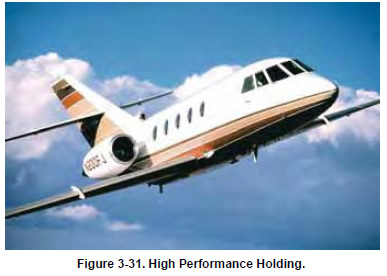|
HIGH PERFORMANCE HOLDING
Certain limitations come into
play when you operate at higher
speeds; for instance, aircraft do
not make standard rate turns in
holding patterns if the bank
angle will exceed 30 degrees. If
your aircraft is using a flight
director system, the bank angle
is limited to 25 degrees. Since
any aircraft must be traveling at
over 210 knots TAS for the bank
angle in a standard rate turn to
exceed 30 degrees, this limit
applies to relatively fast airplanes.
An aircraft using a flight
director would have to be holding
at more than 170 knots TAS
to come up against the 25
degrees limit. These true airspeeds
correspond to indicated
airspeeds of about 183 and 156
knots, respectively, at 6,000
feet in a standard atmosphere
[Figure 3-31 on page 3-26].
Since some military airplanes need to hold at higher speeds than the
civilian limits, the maximum at military
airfields is higher. For example, the
maximum holding airspeed at USAF
airfields is 310 KIAS.

FUEL STATE AWARENESS
In order to increase fuel state awareness,
commercial operators and other professional
flight crews are required to record
the time and fuel remaining during IFR
flight. For example, on a flight scheduled
for one hour or less, the flight crew may
record the time and fuel remaining at the
top of climb (TOC) and at one additional
waypoint listed in the flight plan.
Generally, TOC is used in airplanes with a flight management
system, and represents the point at which
cruise altitude is first reached. TOC is calculated based
on current airplane altitude, climb speed, and cruise
altitude. The captain may elect to delete the additional
waypoint recording requirement if the flight is so short
that the record will not assist in the management of the
flight. For flights scheduled for more than one hour, the
flight crew may record the time and fuel remaining
shortly after the top of climb and at selected waypoints
listed in the flight plan, conveniently spaced approximately
one hour apart. The flight crew compares
actual fuel burn to planned fuel burn. Each fuel tank
must be monitored to verify proper burn off and
appropriate fuel remaining. On two pilot airplanes, the pilot monitoring (PM) keeps the flight plan record.
On three pilot airplanes, the second officer and PM
coordinate recording and keeping the flight plan
record. In all cases, the pilot making the recording
communicates the information to the pilot flying.
|

